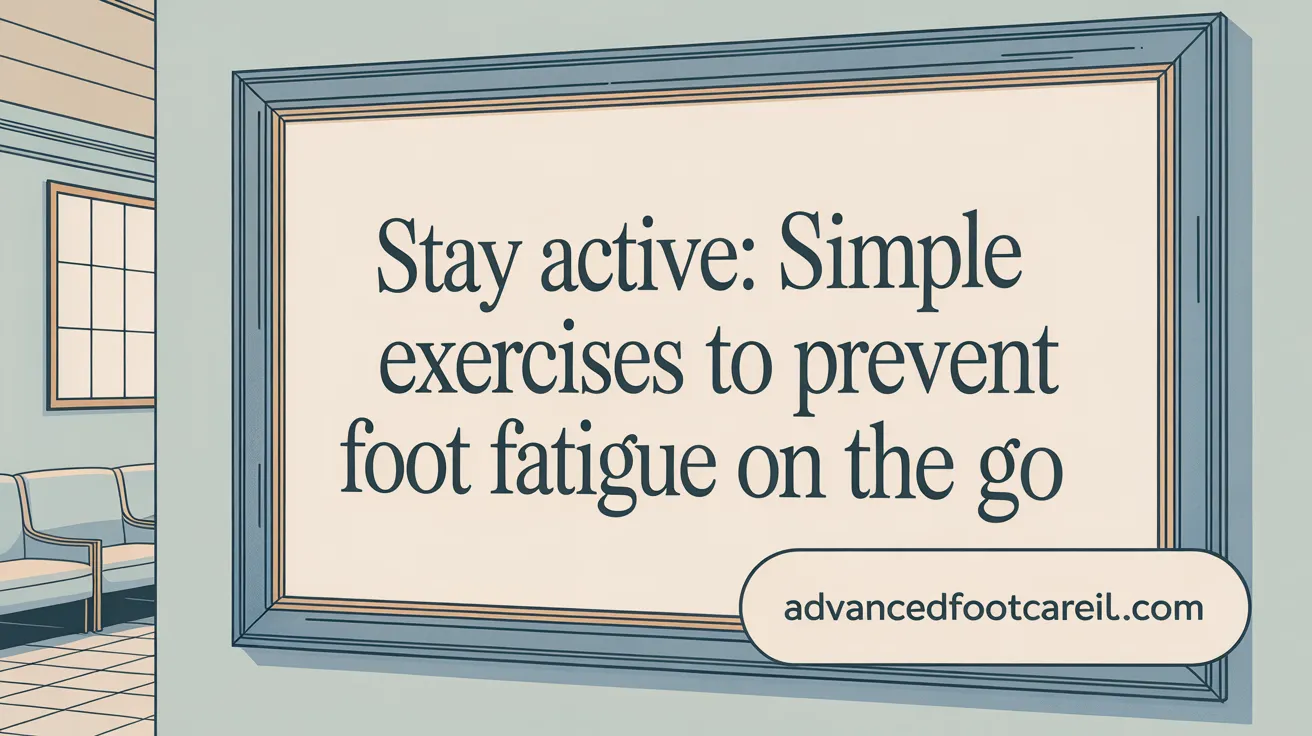Why Foot Care Matters on the Road
Long travel days packed with walking, standing, and exploring can take a toll on your feet. Without proper care, foot fatigue, swelling, blisters, and discomfort can quickly spoil a vacation or business trip. This guide distills expert advice and practical tips to keep your feet healthy, comfortable, and energized from departure to return.
Choosing the Right Footwear for Travel Comfort and Support

What are the recommendations for choosing comfortable and supportive footwear for travel?
Selecting the right shoes is crucial for maintaining foot health and comfort during travel. Experts recommend opting for footwear that offers good arch support and cushioning, helping to distribute pressure evenly across the foot and reduce fatigue. Slip-on styles with adjustable straps and stretchable uppers are especially convenient for airport security and long walks.
Look for travel shoes that are lightweight yet sturdy, with multi-layered cushioning to absorb shock and lessen impact on the joints. Breathable materials like mesh or mesh linings help keep your feet dry and comfortable, preventing issues like blisters and fungal infections.
Footwear tailored to your planned activities—such as hiking boots for outdoor excursions or supportive sneakers for city sightseeing—can prevent injuries and provide necessary stability. Breaking in new shoes before your trip ensures they won’t cause blisters or discomfort during extended wear.
If you have specific foot support needs, incorporating orthotics or insoles can enhance comfort. These supportive inserts help realign your feet, alleviate pressure points, and reduce the risk of pain and injury.
Avoid wearing untested or new shoes on travel days; instead, choose well-worn pairs that have been broken in. For added convenience, slip-on shoes are preferred for ease of taking them off at security checks and for quick changes during long travel hours.
By selecting shoes that combine support, comfort, and adaptability, you can enjoy your travels while keeping your feet healthy and happy.
Essential Foot Care Routines During Travel
 Maintaining foot health during travel requires attentive routines and the right gear. Start with wearing comfortable, supportive shoes that fit well and are appropriate for your planned activities. Avoid breaking in new shoes during trips to prevent blisters. Regularly cleaning and thoroughly drying your feet helps prevent fungal infections like athlete’s foot. Moisturizing your feet daily keeps skin supple and reduces cracking, especially after exposure to water or dry environments.
Maintaining foot health during travel requires attentive routines and the right gear. Start with wearing comfortable, supportive shoes that fit well and are appropriate for your planned activities. Avoid breaking in new shoes during trips to prevent blisters. Regularly cleaning and thoroughly drying your feet helps prevent fungal infections like athlete’s foot. Moisturizing your feet daily keeps skin supple and reduces cracking, especially after exposure to water or dry environments.
Packing foot care essentials such as moisture-wicking socks, blister plasters, antifungal powders, nail care tools, and bandages ensures you're prepared for minor issues. When spending long hours on flights or car rides, wearing compression socks can improve circulation and reduce swelling. During stops, take the opportunity to stretch your feet and calves and elevate your legs when possible to boost blood flow.
In unfamiliar or humid environments, avoid walking barefoot in public areas to reduce exposure to infections and injuries. Regular foot inspections for dryness, cracks, calluses, or signs of infection can help catch problems early. If you notice redness, pain, or persistent discomfort, seek prompt medical attention.
By integrating these routines into your travel, you help prevent common foot ailments, maintain comfort, and stay active throughout your journey. Remember, good hygiene, timely care of minor issues, and proper footwear are your best tools for healthy feet while exploring new places.
Exercises and Stretches to Prevent and Alleviate Foot Fatigue

What exercises and stretches are effective for preventing or alleviating foot fatigue?
To keep your feet healthy and comfortable during travel or long days on your feet, performing specific exercises and stretches can make a significant difference.
Effective exercises include toe curls, toe spreads, and towel scrunches. These activities help strengthen the muscles in your toes and the bottom of your feet, improving control and reducing fatigue. Simply curl your toes around a small towel on the floor and scrunch it towards you, or spread your toes apart widely. These exercises are simple to do at home or even during travel.
Stretching your calves, Achilles tendons, and the soles of your feet enhances flexibility and relieves tension. Techniques like heel raises, where you lift your heels off the ground, and standing lunges help stretch the calf muscles. Toe squat stretches, where you bend your toes backward while kneeling, also target the arch area.
Ankle mobility exercises, such as circular rotations and rocking your foot forward and backward against a wall, help keep your ankle joints flexible and promote good circulation.
Using massage balls, such as a tennis or golf ball, under your foot can release tightness in the plantar fascia and surrounding tissues, easing fatigue and discomfort. Foot massage with tennis balls is highly recommended.
For best results, perform these exercises regularly—ideally daily or at least several times a week. Aim for 2-3 sets of 10-15 repetitions, and hold stretches for 20-30 seconds. Consistency is key to maintaining foot health, especially during travel or after prolonged standing.
Incorporating these exercises into your routine not only prevents fatigue but also supports overall foot strength and flexibility, helping you stay comfortable and active wherever your travels take you.
Preventing Common Foot Problems on the Road
Traveling often involves extended periods of walking, standing, and exposure to different environments, which can put extra stress on your feet. However, there are effective measures to keep your feet healthy and prevent discomfort.
A primary step is selecting proper footwear. Wearing supportive, well-fitting shoes with good arch support and cushioned soles helps prevent blisters, calluses, and injuries. Combining this with moisture-wicking socks reduces moisture buildup, decreasing the risk of blisters and fungal infections.
Using blister prevention products like blister pads or moleskin can provide an additional layer of protection against friction. Carrying a small first aid kit with bandages, antiseptic cream, and pads ensures you're prepared to treat minor injuries promptly, preventing worsening complications.
Managing swelling during travel is essential. Wearing compression socks especially during long flights or drives, supports circulation and reduces edema. Staying hydrated and avoiding salty foods further helps decrease fluid retention.
In addition to supportive footwear, taking regular breaks is vital. Elevating your feet when seated, stretching your legs, and doing simple seated exercises like ankle circles or foot pumps can significantly improve blood flow. It’s also important to avoid crossing legs for long periods, as this can restrict circulation.
Practicing good foot hygiene by washing and thoroughly drying your feet after walking in public areas prevents infections. Protect your feet from hot surfaces by wearing appropriate shoes or sandals, especially in warm environments, and always use foot protection when in communal showers or around pools.
In summary, combining the right footwear, hygiene practices, and gentle exercises creates a comprehensive approach to prevent common travel-related foot problems such as swelling, blisters, and injuries. These simple steps ensure that foot discomfort doesn't interfere with your travel experience.
More info search query: Foot care to prevent travel blisters and swelling
This approach not only enhances comfort but also secures foot health during your journeys, allowing you to enjoy your trip to the fullest.
In-Flight and On-The-Go Foot Care Strategies
 Traveling often involves extended periods of sitting, walking, and exposure to different environments that can put your feet at risk of fatigue, swelling, and discomfort. To keep your feet healthy and comfortable during journeys, incorporate some simple yet effective foot care practices.
Traveling often involves extended periods of sitting, walking, and exposure to different environments that can put your feet at risk of fatigue, swelling, and discomfort. To keep your feet healthy and comfortable during journeys, incorporate some simple yet effective foot care practices.
Performing seated foot exercises and stretches regularly is crucial. Every hour, make time to flex and point your toes, do ankle circles, and gently stretch your calves. These movements stimulate circulation, reduce stiffness, and prevent muscle cramps.
Wearing compression socks during flights or long drives is highly recommended. These specially designed socks apply gentle pressure, helping to decrease swelling, improve blood flow, and reduce the risk of deep vein thrombosis (DVT). They are especially beneficial if you have pre-existing circulation concerns or are prone to edema.
Choosing slip-on, comfortable shoes for travel also plays a vital role. Supportive slip-ons or loafers allow easy removal at security checks and promote better foot health by reducing friction and pressure on your feet. Avoid new shoes or those that are tight to prevent blisters and discomfort.
Additional tips include elevating your feet whenever possible, especially during long periods of sitting. Elevation helps return blood from the lower limbs, reducing swelling and fatigue. Staying well-hydrated with water further aids circulation and keeps your skin moist, preventing dryness and cracking.
Packing a travel foot care kit is a smart move. Essentials such as blister pads, moisturizer, antiseptic ointments, and first-aid supplies can help manage minor issues promptly and prevent infections.
It's also advisable to avoid tight shoes or new footwear when in transit. Instead, opt for shoes that are proven to be comfortable and roomy, ensuring your feet are supported without unnecessary compression.
Finally, walking breaks during long journeys are essential. Every hour, stand up, stretch your legs, and walk around to improve circulation and break up sedentary periods.
By following these in-flight and travel-specific foot care strategies, you can enjoy your trip with minimal discomfort, keeping your feet healthy and ready for your adventures.
Post-Travel Foot Recovery and Maintaining Long-Term Foot Health
After a long travel day, giving your feet proper care is essential to relieve fatigue and prevent future problems. One effective method is soaking your feet in warm water with Epsom salts, which can reduce inflammation and soothe tired muscles. Alternatively, immersing your feet in cold water helps decrease swelling and numb discomfort.
Self-massage techniques, such as gently rolling a frozen water bottle or tennis ball under your feet, can improve circulation and release tension. Elevating your feet on a stool or pillow for 15-20 minutes further promotes blood flow, reduces swelling, and speeds up recovery.
Keeping your skin moisturized after travel is vital. Applying rich creams containing shea butter or coconut oil helps prevent dryness and cracking, especially following exposure to water or dry environments.
Wearing compression socks designed for recovery can improve circulation and minimize swelling if you frequently experience tired or swollen feet.
Maintaining flexibility through regular stretching exercises for your calves and arches enhances blood flow and prevents stiffness. Additionally, replacing worn-out or unsupportive shoes with comfortable, well-fitting footwear supports your foot health long-term.
Be attentive to persistent or severe foot pain, and consult a healthcare professional if necessary. Combining these post-travel care routines ensures your feet recover well and stay healthy for your next adventure.
Keeping Your Feet Happy on Every Journey
Taking care of your feet before, during, and after travel is vital to enjoy a comfortable and pain-free trip. Selecting the right footwear, maintaining rigorous foot hygiene, performing targeted exercises, and being prepared with essential foot care supplies can significantly reduce foot fatigue and prevent common travel-related foot problems. Remember to listen to your body’s signals and seek professional advice when needed to safeguard your foot health. Embrace these strategies to keep your feet energized and ready for every adventure that lies ahead.
